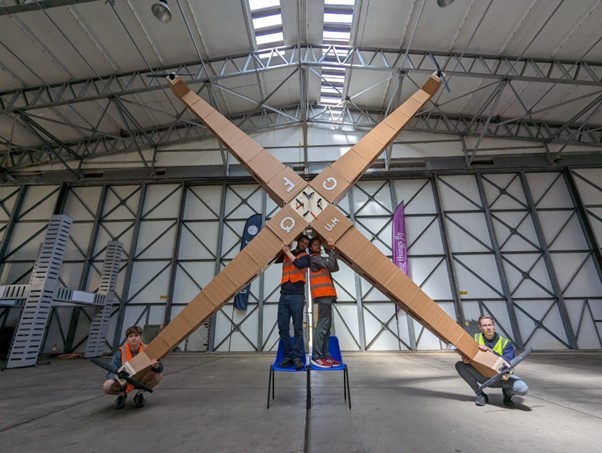A group of engineers at the University of Manchester have achieved a remarkable feat by constructing and successfully flying the world's largest quadcopter drone.
This colossal drone, measuring an impressive 6.4 meters (21 feet) from corner to corner, was crafted from a material known as foamboard. Weighing in at 24.5 kilograms, it just narrowly meets the weight limit set by the Civil Aviation Authority.

The GFQ's Design of the Drone
The drone's innovative design dubbed the Giant Foamboard Quadcopter (GFQ), is unlike any other existing drone. Its four arms are constructed from a series of hollow box structures, offering a unique combination of structural integrity and reduced weight.
This distinctive feature allows for easy disassembly, aiding in transportation. Notably, there is no record of a purpose-built uncrewed quadcopter of any weight class surpassing the size of the Manchester vehicle at present.
This venture initially sparked from a desire to stimulate students' creativity in design by exploring alternative low-cost materials for lightweight aerospace structures, such as the environmentally friendly foamboard, instead of conventional carbon fiber.
Unlike carbon fiber, low-density sheet materials, like foamboard, can be highly recyclable or even compostable, potentially paving the way for more sustainable aerospace designs in the future.
Dan Koning, a research engineer at the University of Manchester who spearheaded the GFQ's design and construction, emphasized the significance of foamboard as a material.
According to Koning, when used judiciously, it enables the creation of complex aerospace structures where each component is engineered precisely to meet its required strength, eliminating unnecessary over-engineering.
Although initially designed as a proof-of-concept, subsequent versions of this vehicle may be customized for tasks like ferrying substantial loads over limited distances or operating as a central drone in air-to-air docking trials.
Crafted from a 5mm thick foamboard that incorporates a core of foam and outer paper skin, the sheets were intricately shaped with laser precision and pieced together to form the intricate 3D framework using hot melt adhesive.
GFQ is driven by four electric motors, drawing power from a 50-volt battery unit, and is equipped with an onboard flight control system enabling autonomous navigation.
The Maiden Flight of Drone
The maiden flight occurred on July 5 inside the primary hangar at the Snowdonia Aerospace Centre as part of the CASCADE Collaboration Workshop Week.
This event provided a platform for numerous university teams across the UK to display their most recent research endeavors. This achievement builds on the success of an equally sizeable fixed-wing foamboard aircraft in 2022.
Subsequently, a student society focused on the development of large-scale foamboard UAVs was established at the University. Moving forward, the team aims to refine the design of the Giant Foamboard Quadcopter, drawing on the lessons learned from this pioneering vehicle to create an even larger iteration.
"Working with foamboard provides a unique learning opportunity for students to experiment with innovative structural designs. Although the material is strong for its weight, it requires significant engineering skill to exploit its structural potential," Bill Crowther, a Professor of Aerospace Engineering at The University of Manchester, said in a statement.
"Ultimately, with this design you are holding up 25kg of aircraft with just a few strategically placed pieces of paper - that's the art of the possible," he added.
Related Article : Researchers Turn to AI to Prevent Autonomous Drone Collisions

ⓒ 2025 TECHTIMES.com All rights reserved. Do not reproduce without permission.




